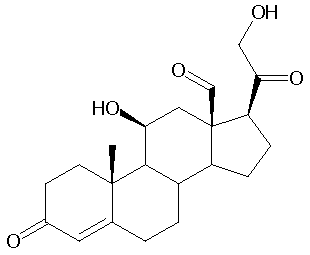|
|
Aldosterone
 Chemical structure of
Chemical structure of
the steroid hormone. |
Aldosterone functions to maintain an adequate ECV by regulating the
amount of sodium reabsorbed in the tubule. Aldosterone is a steroid hormone
produced in the glomerulosa cells of the adrenal cortex. By binding to
the intracellular mineralocorticoid receptor, aldosterone changes the
shape of the receptor allowing for DNA binding. This, in turn, leads
to the production of new proteins that will serve to increase sodium
reabsorption.
Although the exact mechanisms are not known, aldosterone increases the
number of open sodium channels in the apical surface of principal cells.
In addition, aldosterone increases the number of sodium-potassium pumps
on the basolateral surfaces of these cells. (Aldosterone also acts on
the thick ascending limb and the distal convoluted tubule, but its main
effects are on the principal cells of the collecting ducts. Interestingly,
aldosterone also acts on sweat glands to reduce the loss of sodium in
perspiration acts on taste cells to increase the sensitivity of the taste
buds to sources of sodium.)
More>
|
